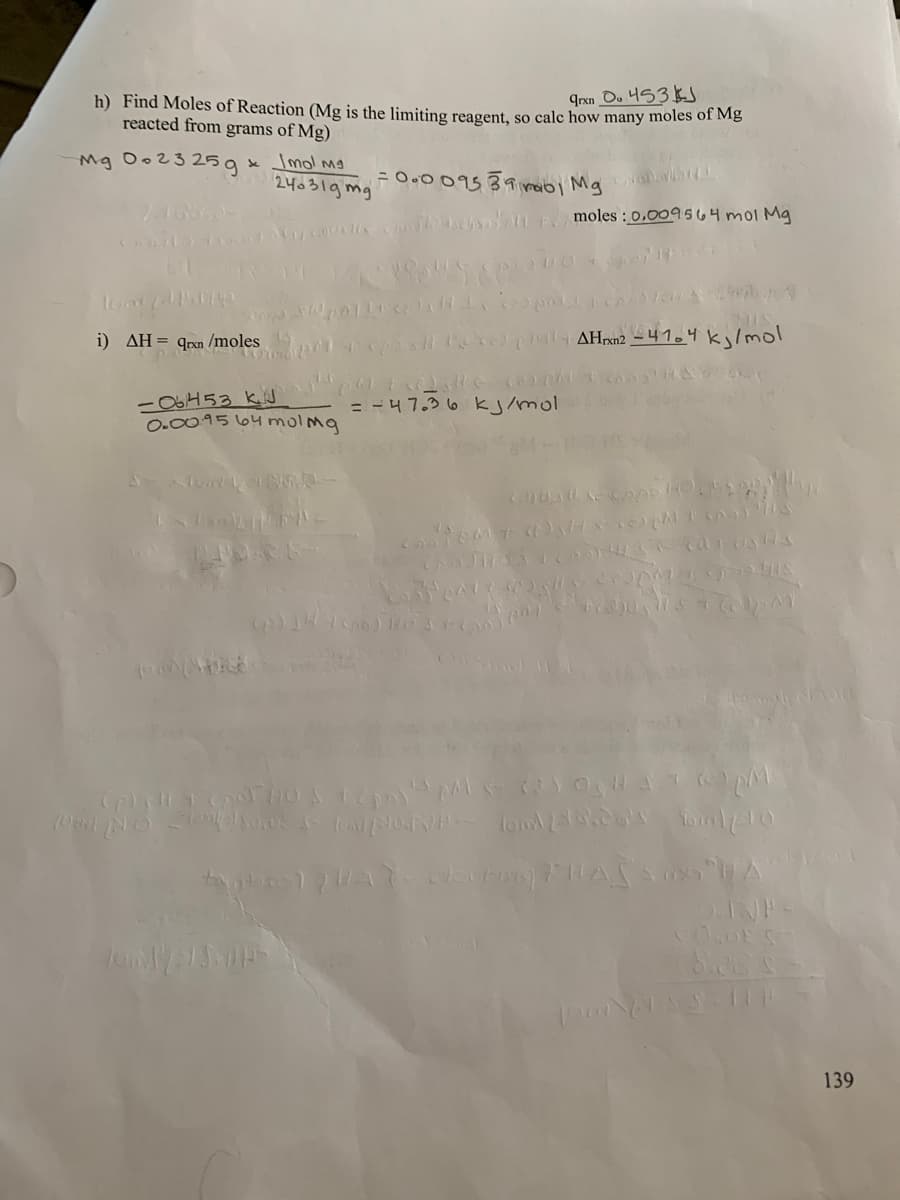h) Find Moles of Reaction (Mg is the limiting reagent, so calc how many moles of Mg reacted from grams of Mg) 9rxn O. 453 ng 0.23 25g * /mol mg 2.168.3- 3 i) AH = qrxn /moles 240319 mg 0.0095 39 mb) Mga y counts A -06453 kJ A5111 spl) + past moles: 0.009564 mol Mg 4 AHrxn2-4104 kj/mol =-47.36 kj/mol 1.76
h) Find Moles of Reaction (Mg is the limiting reagent, so calc how many moles of Mg reacted from grams of Mg) 9rxn O. 453 ng 0.23 25g * /mol mg 2.168.3- 3 i) AH = qrxn /moles 240319 mg 0.0095 39 mb) Mga y counts A -06453 kJ A5111 spl) + past moles: 0.009564 mol Mg 4 AHrxn2-4104 kj/mol =-47.36 kj/mol 1.76
Principles of Modern Chemistry
8th Edition
ISBN:9781305079113
Author:David W. Oxtoby, H. Pat Gillis, Laurie J. Butler
Publisher:David W. Oxtoby, H. Pat Gillis, Laurie J. Butler
Chapter12: Thermodynamic Processes And Thermochemistry
Section: Chapter Questions
Problem 42P
Related questions
Question
I don't think I did this right.

Transcribed Image Text:h) Find Moles of Reaction (Mg is the limiting reagent, so calc how many moles of Mg
qrxn Ou 453
reacted from grams of Mg)
Mg Do 23 25g * Imol mg
24031g mg
i) AH = qrxn /moles
en
-06453 k
0.0095 64 mulig
Sun Ve NG-
NAVNE
1038
10 polecela da pra caster's
CFIGHT CAN HOS
(0) NO
So,
TOMISSIS
= 0.009539 mabl Mg
moles: 0.009564 mol Mg
pallpAHxn2-4164 kj/mol
= -47.36 kJ/mol
dal second
CASTEMT CASHMus
Content
CAJHOST) estis
cont
MY OH 7 ) M
tad po tom 21.06's ton/10
HAR-cscborg HAS A
COROEST
139
![3) Calculate qn and AH for the 1 M HC1/Mg Ribbon Rxn.
The amount of energy the reaction gives off (-qrnx) is given to the solution in the calorimeter
and the calorimeter itself. This means that -qrxn is equal to the amount of energy the solution
absorbed (qso) and the energy the calorimeter absorbs (qeal) Mathematically, the equation that
describes this is:
-qrxn (qsol +qcal) or
qrxn-[(msol X Csol X AT) + (Ccal X AT)]
Note that Tmax is the final temperature for all species when calculating the AT. To convert
volume of the solution to g of solution use the following: the density of 1 M HCl is 1.01 g/mL.
The specific heat of the solution is 4.04 J/g °C.
Calculate the following:
qrxn=-(qsol+qcal)
a) Volume of HCl(from data)
VHCI 100..
b) Find mass of the solution using the mL of HCl and the density given above
100.0 mL x 1001 g/mL = 10lg g
c) Find the initial temp of the HCI (from data)
d) Find the maximum reaction temp from data
He) Find AT
(AT=Tmax-Tinitial)
33.2°C -20.2°C =
g) Convert qrn to kJ
lks
-4535
1000)
msol: 10.09
*H0all Joe.de
Tinital: 20-2°C
Tmax: 33.22
f) Find qrxn
2009 (9rxn=- [(msol X Csol X AT) + (Ccal X AT)]) where Csol is given above, and Ccal is
calculated in part 1.
ΔΤ: [3.00 c°
-[(1010gx 4:04 J/g °C x 13.006) + (23602 j/2 x 13.00) = -452.78
-153.92 +-299.26
9rxn-4531
(should be negative)
0.453k
138](/v2/_next/image?url=https%3A%2F%2Fcontent.bartleby.com%2Fqna-images%2Fquestion%2Facf8e957-4fbe-471c-af8b-521f0436b36d%2F4d9d6182-74a4-4a00-81f8-fff6de475f6e%2Fmfwtinc_processed.jpeg&w=3840&q=75)
Transcribed Image Text:3) Calculate qn and AH for the 1 M HC1/Mg Ribbon Rxn.
The amount of energy the reaction gives off (-qrnx) is given to the solution in the calorimeter
and the calorimeter itself. This means that -qrxn is equal to the amount of energy the solution
absorbed (qso) and the energy the calorimeter absorbs (qeal) Mathematically, the equation that
describes this is:
-qrxn (qsol +qcal) or
qrxn-[(msol X Csol X AT) + (Ccal X AT)]
Note that Tmax is the final temperature for all species when calculating the AT. To convert
volume of the solution to g of solution use the following: the density of 1 M HCl is 1.01 g/mL.
The specific heat of the solution is 4.04 J/g °C.
Calculate the following:
qrxn=-(qsol+qcal)
a) Volume of HCl(from data)
VHCI 100..
b) Find mass of the solution using the mL of HCl and the density given above
100.0 mL x 1001 g/mL = 10lg g
c) Find the initial temp of the HCI (from data)
d) Find the maximum reaction temp from data
He) Find AT
(AT=Tmax-Tinitial)
33.2°C -20.2°C =
g) Convert qrn to kJ
lks
-4535
1000)
msol: 10.09
*H0all Joe.de
Tinital: 20-2°C
Tmax: 33.22
f) Find qrxn
2009 (9rxn=- [(msol X Csol X AT) + (Ccal X AT)]) where Csol is given above, and Ccal is
calculated in part 1.
ΔΤ: [3.00 c°
-[(1010gx 4:04 J/g °C x 13.006) + (23602 j/2 x 13.00) = -452.78
-153.92 +-299.26
9rxn-4531
(should be negative)
0.453k
138
Expert Solution
This question has been solved!
Explore an expertly crafted, step-by-step solution for a thorough understanding of key concepts.
Step by step
Solved in 4 steps

Knowledge Booster
Learn more about
Need a deep-dive on the concept behind this application? Look no further. Learn more about this topic, chemistry and related others by exploring similar questions and additional content below.Recommended textbooks for you

Principles of Modern Chemistry
Chemistry
ISBN:
9781305079113
Author:
David W. Oxtoby, H. Pat Gillis, Laurie J. Butler
Publisher:
Cengage Learning

Chemistry: Matter and Change
Chemistry
ISBN:
9780078746376
Author:
Dinah Zike, Laurel Dingrando, Nicholas Hainen, Cheryl Wistrom
Publisher:
Glencoe/McGraw-Hill School Pub Co

Chemistry
Chemistry
ISBN:
9781305957404
Author:
Steven S. Zumdahl, Susan A. Zumdahl, Donald J. DeCoste
Publisher:
Cengage Learning

Principles of Modern Chemistry
Chemistry
ISBN:
9781305079113
Author:
David W. Oxtoby, H. Pat Gillis, Laurie J. Butler
Publisher:
Cengage Learning

Chemistry: Matter and Change
Chemistry
ISBN:
9780078746376
Author:
Dinah Zike, Laurel Dingrando, Nicholas Hainen, Cheryl Wistrom
Publisher:
Glencoe/McGraw-Hill School Pub Co

Chemistry
Chemistry
ISBN:
9781305957404
Author:
Steven S. Zumdahl, Susan A. Zumdahl, Donald J. DeCoste
Publisher:
Cengage Learning


Chemistry: An Atoms First Approach
Chemistry
ISBN:
9781305079243
Author:
Steven S. Zumdahl, Susan A. Zumdahl
Publisher:
Cengage Learning

Chemistry: Principles and Reactions
Chemistry
ISBN:
9781305079373
Author:
William L. Masterton, Cecile N. Hurley
Publisher:
Cengage Learning